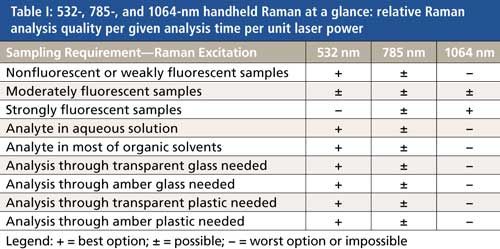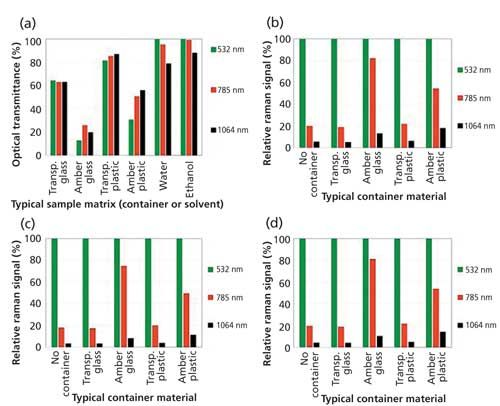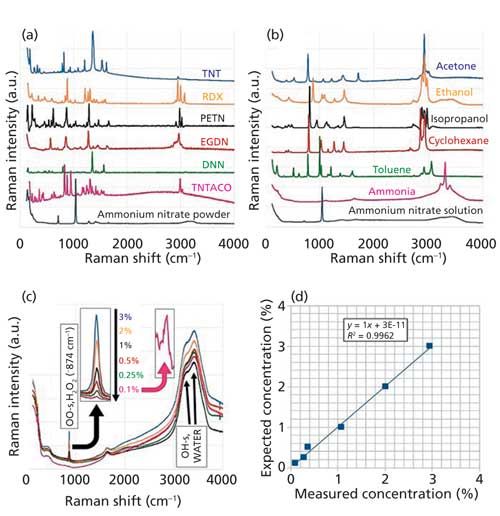Recent Developments in Handheld Raman Spectroscopy for Industry, Pharma, Forensics, and Homeland Security: 532-nm Excitation Revisited
Special Issues
Recent advances in Raman instrumentation have resulted in the development of easy-to-use and efficient handheld Raman analyzers. Most of the commercially available handheld Raman devices utilize 785 or 1064 nm excitation. This paper directly demonstrates the performance of 532 nm handheld Raman (versus 785 and 1064 nm) for the analysis of biopharmaceuticals for structure and counterfeit testing as well as explosive detection (TSA screening and CSI applications). The results presented here will contribute to recognition of 532 nm Raman excitation as a highly attractive option for a rapid “in-place” analysis in the field.
Recent advances in Raman instrumentation have resulted in the development of easy-to-use and efficient handheld Raman analyzers. Most of the commercially available handheld Raman devices use 785- or 1064-nm excitation. This article directly demonstrates the performance of 532-nm handheld Raman (versus 785- and 1064-nm excitation) for the analysis of biopharmaceuticals for structure and counterfeit testing as well as explosive detection. The results presented here will contribute to recognition of 532-nm Raman excitation as a highly attractive option for rapid and effortless analysis in the field.
Raman spectroscopy is well known for its high sensitivity to chemical structure and composition, noncontact, noninvasive, and nondestructive nature of its measurements, with little or no sample preparation required (1). Furthermore, recent engineering and analytical methodology breakthroughs, including fluorescence compensation, allow full use of the intrinsically broad applicability of Raman spectroscopy. These include medical diagnostics (2), pharmaceutical analysis (3), counterfeit medicine testing (4), explosive detection (5), cultural heritage (6), and many others.
Arguably, one of the most important recent advances in Raman spectroscopy is the development of efficient and easy-to-use miniature portable or handheld Raman systems. In addition, most of these handheld systems are capable of analyzing substances directly through containers and packages to eliminate any need for sample preparation or handling and exposure to the chemicals.
These recent developments have made Raman directly suitable for a variety of field applications, where bringing samples to a laboratory is impractical. At this time, there are more than 20 commercial handheld Raman analyzers from more than 10 manufacturers on the market. The key factors to consider when choosing the best available unit for a particular application are briefly presented and discussed below.
Goals of This Study
The first goal of this study is to present semitheoretical, semiempirical considerations to help an end user choose a handheld Raman unit that best suits his or her intended field application. Performance data for comparison are summarized in Table I and Figure 1.


Figure 1: Relative performance (per unit laser power) of 532-, 785-, and 1064-nm handheld Raman for analytes in common sample matrices. Shown are results for (a) optical transmittance, (b) pure analyte, (c) analyte in water, and (d) analyte in ethanol.
The second goal is to revisit or explain why the excitation at 532 nm is the best choice or business case for many practical applications. Briefly, 532-nm excitation enables twofold reduction of instrument costs and up to 5â16 times improved analysis speed and accuracy (Figure 1). In this article, the superior performance of 532-nm handheld Raman is directly demonstrated for counterfeit biologics testing and fastest-in-class explosive detection.
532-, 785-, or 1064-nm Excitation for Handheld?
The excitation wavelength of a handheld Raman analyzer largely determines the strength of Raman signal (analysis speed and accuracy); as well as a propensity for unwanted fluorescence background to occur. In addition, efficiency of all optical elements and quantum efficiency of a relevant detector (charge-coupled device [CCD] for ultravioletâvisible [UVâvis] or InGaAs for visânear infrared [NIR]), as well as spectral resolution limits are also impacted by the choice of laser excitation wavelength.
Most of the commercially available handheld Raman units use 785- or 1064-nm excitations. Only a few of the most recently produced handheld Raman systems use other excitation wavelengths, including 532 nm. The introduction of these new units was aided by recent advances in analytical methodology to significantly reduce the impact of fluorescence on Raman measurements.
Even though more than one of the commercially available excitations might be technically feasible for a given field application, usually only one of these excitations can provide the best business case and analytical solution for a particular application. To select the best excitation wavelength, all of the following factors must be carefully considered:
- Analysis speed and accuracy at each excitation wavelength
- Fluorescence background of intended samples at each excitation wavelength
- Sample matrix transparency: container walls, solvent, analyte, and so forth, around each excitation wavelength.
As for analysis speed and accuracy, 532-nm excitation results in 5- and 16-fold stronger observed Raman signal intensity per unit laser power than those at 785 and 1064 nm, respectively. This is because Raman intensity is inversely proportional to the fourth power of laser excitation wavelength (7), IRaman â(1/λEx)4. In addition, the best-in-class light detectors and optics have higher quantum efficiencies around 532 nm than those available for 785- and 1064-nm systems, to further improve observed Raman signal-to-noise ratios with 532-nm excitation.
In contrast, 1064 nm is a preferred excitation wavelength to minimize fluorescence background. However, the advantage in the unwanted fluorescence reduction is significantly handicapped by ~16 and ~3 times slower analysis compared to 532- and 785-nm systems (per unit laser power), respectively. Thus, 1064-nm excitation can be a preferred analytical solution only in case of the most strongly fluorescent samples (typically dyes or compounds with a significant number of conjugated, double, or triple bonds), whereas in all the other cases 785- and especially 532-nm excitations provide faster analysis.
To account for the impact of sample matrix transparencies on Raman signals, Figure 1a provides measured optical transmittances for a few sample matrixes typical for field analysis. Transmittances for transparent glass (laboratory vial or bottle), amber glass (vial or bottle), transparent plastic (Petri dish, plastic bottle, evidence bag, or blister pack), amber plastic (medical prescription bottle), water, and ethanol are presented.
Using the data in Figure 1a, Figures 1bâd provide a comparative chart for observed relative Raman signal intensities (normalized to 532 nm) to cover several typical situations for field analysis: pure analyte with or without a listed container (Figure 1b); analyte in water solution with or without a container (Figure 1c); and analyte in ethanol solution with or without a container (Figure 1d).
Figure 1 shows that Raman signal intensity at 532 nm is ~25â1600% stronger for all typical field analysis cases considered. The data in Figure 1 are further reduced and summarized in Table I to provide an easy, at-a-glance performance comparison for 532-, 785-, and 1064-nm systems.
The comparison indicates that 532-nm excitation clearly outperforms the 785- and 1064-nm systems in seven out of nine cases as shown in Table I. These cases include all nonfluorescent and weakly fluorescent samples, some fraction of moderately fluorescent samples; measuring through most common glass and plastic containers including amber; as well as analyte detection and quantitation in water (normalization against water OH-stretching band only available with 532 nm) and most organic solvents.
Experimental
All samples were analyzed using a RamTest handheld Raman identifier (BioTools, Inc.), with a 532-nm laser excitation, 120â4000 cm-1 spectral range, and ~4 cm-1 spectral resolution. All tests were run in automated mode, where all measurement parameters are automatically adjusted to optimize signal-to-noise ratio and minimize fluorescence, with remaining fluorescence background (if any) automatically subtracted.
532-nm Handheld Raman for Counterfeit Biologics Detection
One of the most promising new applications for 532-nm handheld Raman is counterfeit biologics detection. The superior performance of 532-nm handheld systems can be explained by the stronger Raman signal and lower absorption of 532-nm light by water compared to 785- and 1064-nm systems (Figure 1). The combination of these two factors enables unmatched analytical power of 532-nm handheld Raman spectroscopy for discrimination and quantitation of various peptides or proteins in aqueous solution.
The growing counterfeit medication problem not only affects pills mainly for cholesterol and erectile dysfunction, but also biologics (cancer drugs) that are administered in doctor`s offices (8). This latter group is an ideal target for counterfeiting as they are high in cost and are parenterally administered medications packaged in vials.
In 2002, counterfeit erythropoietin vials were produced by the original manufacturer, Amgen, but were later up-labeled on the gray market denoting 40,000 U/mL instead of their real content 2000 U/mL. Bogus Avastin came to the United States from abroad in 2012 with obvious defects in labeling (the Roche logo instead of Genentech) and contained cornstarch, acetone, and other chemicals, but no active ingredient to fight cancer. Only portions of the counterfeit vials were discovered in both cases, concluding that the majority of the ineffective drugs must have been administered to patients. Yet, a quick and simple check with a low-cost 532-nm handheld Raman analyzer would have determined the falsely labeled drugs at any stage of the distribution network.
Figure 2 imitates both of the above mentioned incidents, counterfeit biologics with diluted active pharmaceutical ingredients (API) or with no API. We selected two biologics from the top 10 list of best-selling biologic drugs in the world. Three samples were measured in each case: authentic product, diluted API (10% for mimicking up-labeled drug), and formulation buffer (placebo imitating no API case) using a 532 nm handheld Raman analyzer.

Figure 2: Two of the top 10 bestselling biologics measured with 532-nm handheld Raman: (a) biologics sample 1; (b) biologics sample 2. Green = original drug, red = counterfeit drug, and black = buffer or placebo. Data are normalized to the water 3200â3400 cm-1 OH-stretching bands for quantitative API determination.
All specimens were tested using the automated sampling method that requires no previous Raman knowledge. In both cases it was quick, easy, and unambiguous to differentiate the counterfeit drugs from the original ones. These results directly demonstrate that 532 nm handheld Raman could serve as a powerful, low-cost solution for pharmaceutical companies, receiving pharmacies and for end-user doctors’ offices.
532-nm Handheld Raman for Detection of Explosives
Data from the Global Terrorism Database shows that the number of terrorist attacks using explosive devices has dramatically increased within the last decade (9). Numerous analytical methods, including portable Raman, have been developed to enable detection of explosives, and their precursors or breakdown products in the field (5).
Figure 3 directly demonstrates superior performance of 532-nm handheld Raman to enable fastest-in-class, reliable and safe detection, identification, and quantitation of explosives. It should be noted that some of the shown explosives or precursors are considered to be either “strongly fluorescent” (dinitronaphthalene) or “hard to detect” using a handheld Raman (such as cyclotrimethylenetrinitramine [RDX], ammonia, and ammonium nitrate).
Figure 3a shows 532-nm handheld Raman spectra of powdered explosives: trinitrotoluene (TNT), RDX, pentaerithrityl tetranitrate (PETN), ethyleneglycole dinitrate (EGDN), dinitronaphtalene (DNN), tetranitroteraazocyclooctane (TNTACO), and ammonium nitrate powder. Figure 3b shows 532-nm handheld Raman spectra of typical liquid explosives or precursors: acetone, ethanol, isopropanol, cyclohexane, toluene, ammonia, and aqueous solution of ammonium nitrate. It should be noted that 532-nm excitation enables reliable identification and detection of all these substances within 1â5 s. Such a fast and reliable identification is a direct result of the stronger Raman signal at 532-nm excitation compared to those at 785 and 1064 nm.

Figure 3: Spectra of explosives measured by 532-nm handheld Raman spectroscopy: (a) powdered explosives, (b) liquid explosives-precursors, (c) hydrogen peroxide solutions in water, (d) Automated hydrogen peroxide quantitation using 3200â3400 cm-1 OH-s water bands. Insets in (c) show the magnified ~874 cm-1 OO-s hydrogen peroxide band.
One more attractive feature of 532-nm excitation is a stronger dispersion of 532-nm light compared to those at 785 and 1064 nm. This increased light dispersion enables the production of handheld Raman systems with a widest-in-class spectral range of ~100â4000 cm-1, and still the best-in-class spectral resolution of 4â6 cm-1. This broader spectral range directly enables new applications for handheld Raman, including automated quantitation of analytes in aqueous solutions. Figure 3d directly demonstrates automated hydrogen peroxide quantitation in water down to <0.1%. Specifically, 3200â3400 cm-1 OH-stretch bands of water, which are unattainable with today’s commercial 785- and 1064-nm handheld systems, were used as internal intensity standards (Figure 3c).
Conclusions
Our analysis indicates that 532-nm excitation should be revisited as a highly attractive option for handheld Raman spectroscopy. Identified benefits include ~twofold reduced instrument cost, up to 5â16 times faster analysis for a great deal of practical field applications, reduced laser power (enabling safe detection of explosives, reduced laser safety concerns, or laser-induced sample degradation, as well as extending battery continuous operation time), superior performance in water and most organic solvents, the ability to analyze through a large variety of glass and plastic containers (including amber), improved combination of spectral range and spectral resolution, as well as reduced detection limits with improved analysis accuracy.
As a result, 532-nm handheld Raman spectroscopy can dramatically improve business cases for a significant fraction of practical field applications or extend the applicability scope of handheld Raman to new fields. The best applications include, but are not limited to, counterfeit biologics, rapid detection of explosives, identification of individual components in complex mixtures, automated quantitation of analytes in aqueous solutions, diluted analytes in water or organic solvents, and reliable detection of several compounds previously considered “hard to detect” using handheld Raman devices.
References
- Handbook of Vibrational Spectroscopy, J.M. Chalmers and P.R. Griffiths, Eds. (John Wiley & Sons, Chichester, UK, 2002).
- Q. Tu and C. Chang, Nanomedicine: Nanotechnology, Biology, and Medicine, 8, 545â558 (2012).
- T. Vankeirsbilck, A. Vercauteren, W. Baeyens, and G. Van der Weken, Trends Anal. Chem.21(12), 869â877 (2002).
- K. Kwok and L.S. Taylor, J. Pharm. Biomed. Analysis66, 126â135 (2012).
- K.L. Gares, K.T. Hufziger, S.V. Bykov, and S.A. Asher, J. Raman Spectrosc. 47, 124â141 (2016).
- J.M. Madariaga, Anal. Methods7, 4848â4876 (2015).
- D.A. Long, The Raman Effect (John Wiley & Sons, New York, New York, 2002).
- K. Dégardin, Y. Roggo, and P. Margot, J. Pharm. Biomed. Analysis87, 167â175 (2014).
- Open source, Global Terrorism Database, http://www.start.umd.edu/gtd (2015).
Aleksandr V. Mikhonin, Susan Hodi, and Rina K. Dukor are with BioTools Inc., in Jupiter, Florida. Laurence A. Nafie is with BioTools Inc., and the Department of Chemistry at Syracuse University in Syracuse, New York. Direct correspondence to: alex@btools.com

AI-Powered SERS Spectroscopy Breakthrough Boosts Safety of Medicinal Food Products
April 16th 2025A new deep learning-enhanced spectroscopic platform—SERSome—developed by researchers in China and Finland, identifies medicinal and edible homologs (MEHs) with 98% accuracy. This innovation could revolutionize safety and quality control in the growing MEH market.
New Raman Spectroscopy Method Enhances Real-Time Monitoring Across Fermentation Processes
April 15th 2025Researchers at Delft University of Technology have developed a novel method using single compound spectra to enhance the transferability and accuracy of Raman spectroscopy models for real-time fermentation monitoring.
Nanometer-Scale Studies Using Tip Enhanced Raman Spectroscopy
February 8th 2013Volker Deckert, the winner of the 2013 Charles Mann Award, is advancing the use of tip enhanced Raman spectroscopy (TERS) to push the lateral resolution of vibrational spectroscopy well below the Abbe limit, to achieve single-molecule sensitivity. Because the tip can be moved with sub-nanometer precision, structural information with unmatched spatial resolution can be achieved without the need of specific labels.